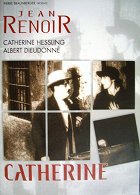Screenplay:
Jean RenoirComposer:
Marc PerroneCast:
Catherine Hessling, Albert Dieudonné, Eugénie Nau, Maud Richard, Georges Térof, René Koval, Julio de Romero, Karl HarbacherReviews (1)
Who knows what we would find if we looked for a woman behind everything? We will actually find one behind Jean Renoir’s debut. Because he didn’t manage to find an appropriate screenplay for his wife, Catherine Hessling, he wrote one himself and directed it in cooperation with Albert Dieudonné (who later starred in Gance’s Napoleon). The gloomy melodramatic plot is as banal as that in the films by Renoir’s contemporaries, but it places emphasis on the social dimension, thus revealing the director’s socialist views. Whereas the authentically dingy setting reminiscent of a German Kammerspiel, close-ups of eyes and the protagonist’s occasional merging with the mis-en-scéne hint at expressionism, it is clear from the scenes with heart-racing rapid montages that Renoir was also enchanted by the modernity of French impressionism. Despite the numerous recognisable influences, the film is somewhat monotonous and long passages flow without any excitement, the absence of which is not made up for even by the brilliantly built-up closing chase scene, which itself is nearly flawless in creating the impression of movement through rapid editing and alternating camera angles (here following a train, there in a car), though it is unsatisfying due to its sudden end, which raises the somewhat silly question “did they run out of film?” The use of juxtaposition during this sequence makes it clear that Catherine’s fear is crucial here. The film was constructed for her and she is its foundation. In the end, this wasn’t a “star vehicle” for Hessling, who had previously made a living by posing nude for Renoir’s father. It’s no wonder. The sadly imploring eyes, looking for compassion behind the camera, the childlike fragility slightly reminiscent of Mary Pickford – none of that, not even the theatrical make-up, can disguise the fact that this lady was not gifted with talent. The camera, together with the editing and sets, does the acting for her. Not one of those elements achieves the intensity and extravagance seen in the more famous French films of the 1920s (by Epstein, Gance and L’Herbier). The modest use of formalistic embellishments rather indicates the restrained style that Renoir later adopted and I consider a study of his work as a whole to be a good reason to watch Backbiters. 65%
()
